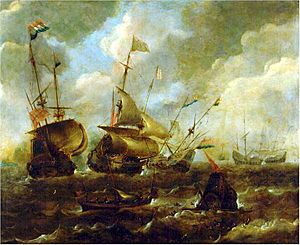Battle off Lizard Point facts for kids
Quick facts for kids Battle off Lizard Point |
|||||||
|---|---|---|---|---|---|---|---|
| Part of the Eighty Years' War | |||||||
 Battle between Dutch and Spanish men-of-war. Oil on copper, Naval Museum of Madrid. |
|||||||
|
|||||||
| Belligerents | |||||||
| Commanders and leaders | |||||||
| Unknown | Admiral Miguel de Horna | ||||||
| Strength | |||||||
| 6 men-of-war 44 merchant ships |
6 galleons 2 frigates |
||||||
| Casualties and losses | |||||||
| 3 warships sunk 3 warships captured 14 merchant ships captured |
No ships lost | ||||||
The Battle off Lizard Point was a naval battle. It happened on February 18, 1637. This fight took place near the coast of Cornwall, England. It was part of the Eighty Years' War. A Spanish admiral named Miguel de Horna led the Spanish fleet. He attacked a large group of Anglo-Dutch merchant ships. These ships were carrying goods and were protected by six warships. The Spanish fleet destroyed or captured 20 of these ships. Admiral Horna then safely returned to his base in Dunkirk.
What Happened Before
In early 1636, a skilled admiral named Jacob Collaert was in charge. He commanded the Armada of Flanders, a fleet from Dunkirk. His fleet was defeated by five Dutch warships. This happened near Dieppe, off the French coast. Collaert's ship and another were sunk. He was captured along with 200 of his men.
After being exchanged for other prisoners, he was set free. But he soon died from an illness. Miguel de Horna took his place as admiral. Horna quickly showed he was a very good commander. In less than two years, he won three big battles. These included the battle off the Lizard, Mardyck, and in the Channel.
The Battle Begins
Miguel de Horna left Dunkirk on February 18. He led a group of five ships and two frigates. His goal was to attack Dutch fishing boats and trade routes. His captains included Antonio de Anciondo and Marcus van Oben.
First, they captured a merchant ship near Calais. Then, the Spanish ships crossed the English Channel. They soon saw a large convoy near Lizard Point in Cornwall. This convoy had 28 Dutch and 16 English merchant ships. Six Dutch warships were protecting them. The Spanish warships quickly moved to attack. They faced heavy fire from the Dutch escort ships.
The Fight at Sea
The Spanish ships attacked the convoy's protectors. Horna's main ship fired heavily on the Dutch flagship. The Dutch flagship was badly damaged. A Spanish ship tried to board it and capture its flag. But this attack failed.
Horna's ship tried again for half an hour. This second attempt also failed. Then, a third Spanish ship joined the fight. With its help, the Dutch flagship was finally captured. The merchant ships also used their cannons to help. But three Dutch warships were still sunk. The remaining two Dutch warships surrendered and were captured.
The convoy ships scattered and tried to escape. They used the smoke from the battle and the darkness of night. However, 14 of them were caught by the Spanish. These ships, along with the three captured warships, were taken to Dunkirk.
After the Battle
Admiral Horna returned to Dunkirk with 17 captured ships. These ships were full of ammunition and supplies. He managed to avoid the Dutch admiral, Philips van Dorp. Dorp had been sent with 20 warships to stop Horna. Dorp tried to block the Spanish fleet in the port. But Horna was able to continue his attacks easily.
Later that July, Horna attacked two Dutch convoys. He captured 12 ships. These ships were carrying important goods, including 125 valuable horses. He also captured a convoy going from Venice to Amsterdam. Plus, he took 14 ships from the Dutch East India Company. Eight other ships carrying gifts for Louis XIII of France were also captured.
In another event on February 18, 1639, Horna was attacked. A Dutch fleet of 17 ships attacked him. Even though he had fewer ships, Horna helped a Spanish convoy escape.
See also

- In Spanish: Batalla de Lizard Point para niños

